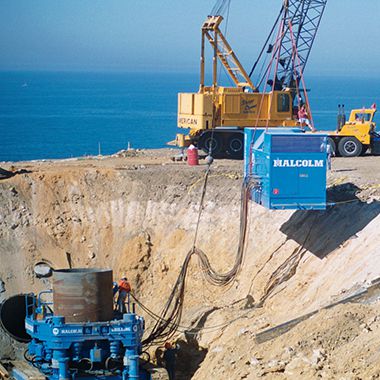A large office building positioned near a busy freeway in CA experienced substantial movement down a slope it was built above, resulting in the city preventing the owner from allowing businesses to occupying the building until it conformed to city/state safety standards. Three years previously the owner had hired an engineering company to confirm whether the location was suitable for building and to provide instructions on grading the area. A second firm observed the grading and prepared a suitable pad for the civil construction. A third engineering company constructed over-the-slope retaining walls to gain more pads and then built the building. They confirmed that they had built everything in accordance with the plan and that the building was suitable for occupancy. Within three years of being finished the building had moved enough that the city deemed it unsafe to use. Additional firms were hired to review the site. They concluded that the shifting was due to landslides and a lawsuit was formed.
Millions of dollars were spent researching and “fixing” the landslide issue with a complicated system of tiebacks. The tiebacks were anchored into the deep underlying bedrock and cables were drilled into the slope, essentially stitching up the hillside. Due to steep terrain and close proximity to the freeway and other buildings, the fix was risky and expensive. When this fix did not prevent further movement, the owner’s lawyer suggested calling in G3 to review the property. Further study showed that those costly fixes did nothing to prevent further movement.
Using the G3 method, G3 researched data that had been collected from thousands of developments, learned the rock mechanics of the area, studied the rock characters for intact rock and damaged material rock from past landslides, and researched the land history from Miocene period until the present to prove the area was not a landslide complex. Rather than spend hundreds of thousands of dollars on drilling (which would not have explained slipping caused by a fold), G3 studied aerial photos from the construction of the freeway, listened to testimonials of people on-site, used cross sections to test theories on 3D models, applied geometry, and practiced their deep understanding of the land tectonics to determine that the movement was related to a fold in the earth. Unlike other firms that built on previous opinions and conclusions, G3 started from the beginning and applied the scientific method to test and uncover the land fold.
To the applause of the city’s engineering firm, Larry was able to determine that the slippage was not a landslide, but was part of a fold belt, which meant that the building owner could occupy the building again. Because movement was still occurring, G3 requested to investigate the slipping tiebacks and to look at the issue of expansive soils and slope creep. Steve discovered what 9 other firms had not been able to determine; backfill from a utility excavation during pre-development was settling and causing the installation to pull down. During construction, the engineering firm installed a utility excavation in the slope below where they were extending the building. The settling backfill pulled down the installation, which created a notch in the slope and caused the building to slide as the land settled. Ultimately, G3 determined that the issue had reached its limit of movement. G3 placed crack meters on the property (costing about $1000) to monitor and observe current cracking. The landowner spent $2-3 million on research, useless fixes, and litigation on a project that would have cost very little through G3.


